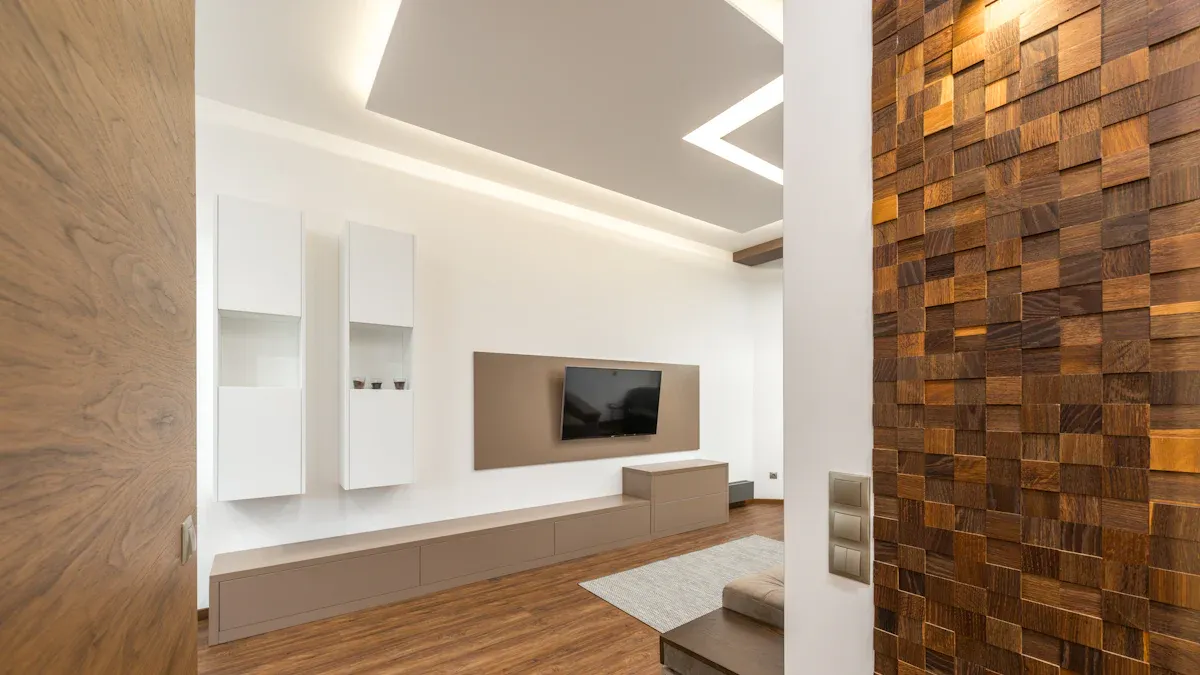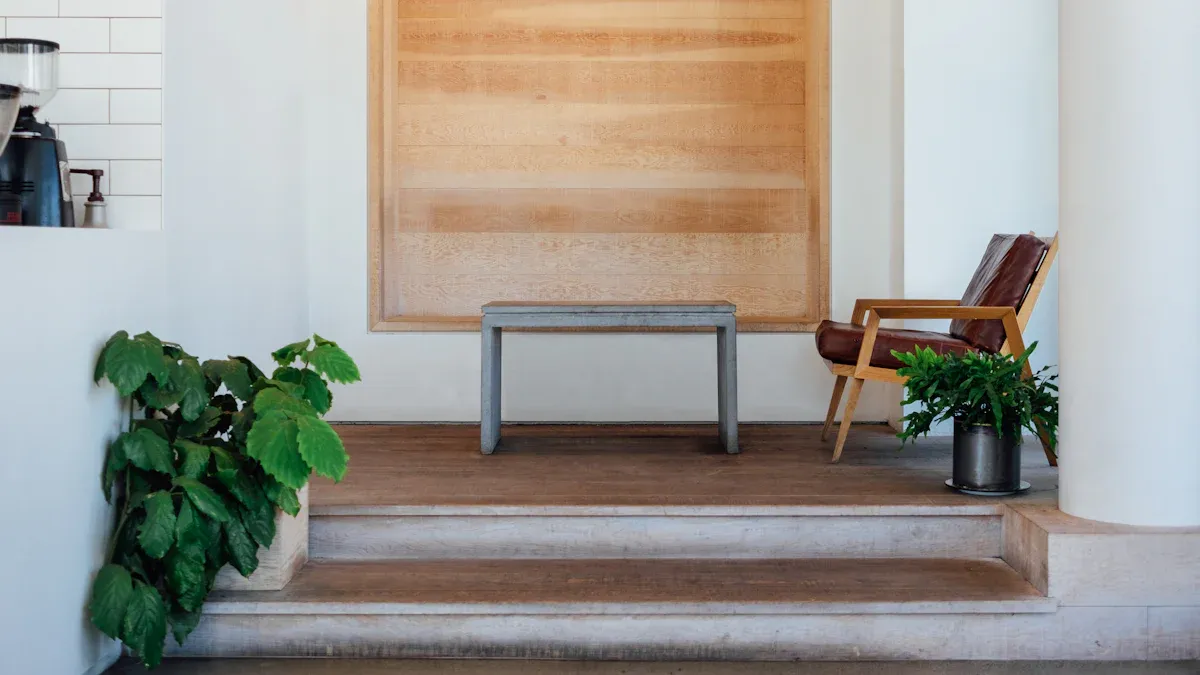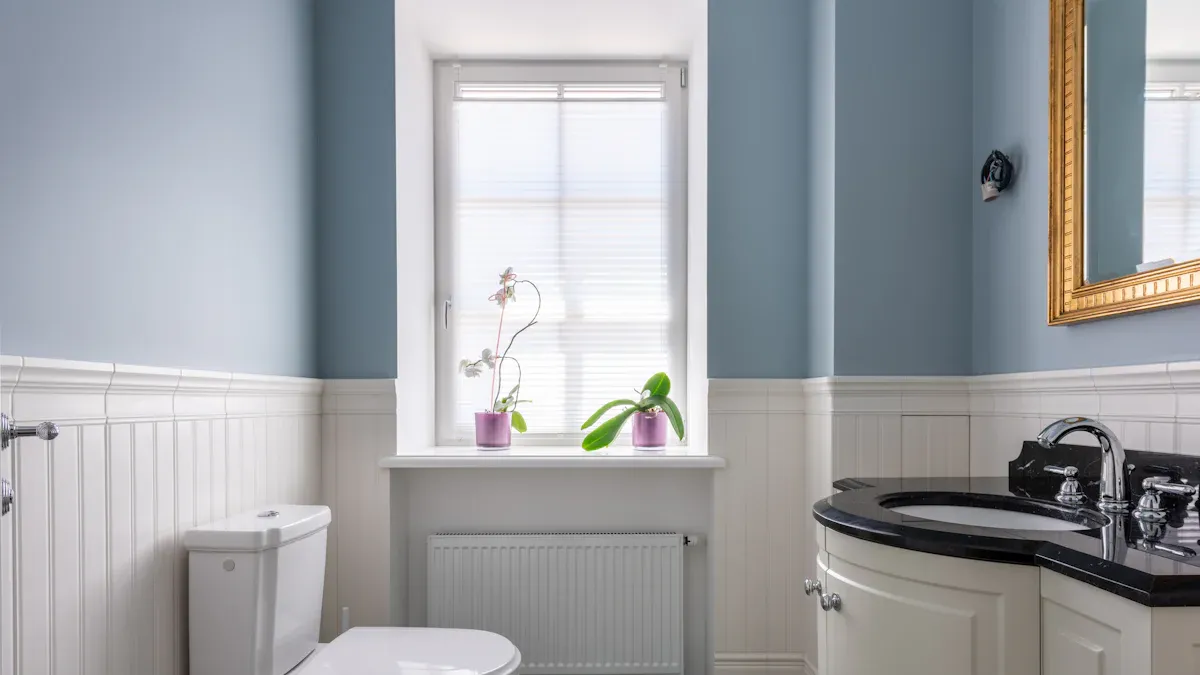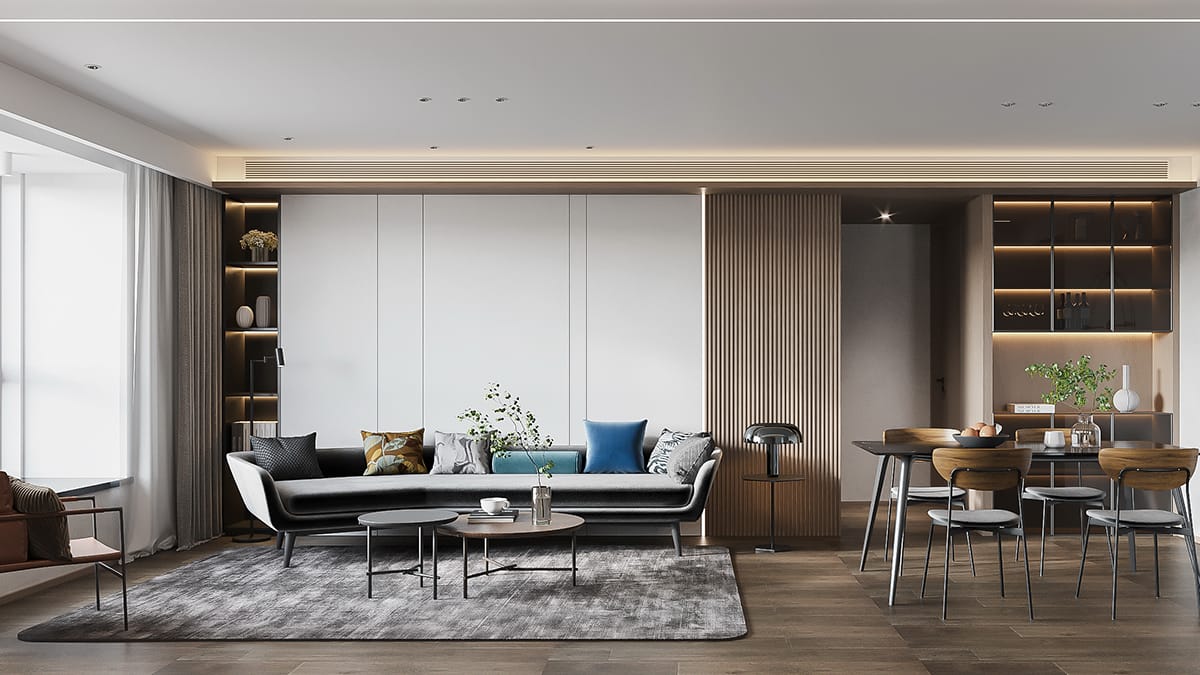
13 Sep 7 Best Boards for Wall Paneling in 2025
Table of Contents
Here are the top 7 boards for wall paneling in 2025. They are natural wood, MDF, PVC panels, plywood, gypsum board, magnesium wall board, and stone veneer. Wall panels are getting more popular. People like their style and how easy they are to put up.
The market will be $23.7 billion by 2034.
People choose wall panels for looks, insulation, and flexibility.
Material | Durability Characteristics |
|---|---|
PVC Panels | Water and corrosion resistant. Easy to clean. Not scratch-resistant. |
Impact and scratch-resistant. Easy to clean. Good for busy places. | |
Gypsum Board | Needs more care. Not very durable. |
MDF | Not very durable. Needs more maintenance. |
Think about your room, budget, and style. The best board for you depends on what you want most.
Key Takeaways
Pick wall panels that fit your room. Wet places like bathrooms need PVC or magnesium boards because they resist water.
Think about how much money you want to spend. MDF and PVC look nice and cost less. Natural wood and stone veneer look fancy but cost more.
Choose wall panels that match your style. Natural wood is good for classic looks. Stone veneer makes rooms look fancy. MDF or PVC work well for modern styles.
1. Natural Wood

Overview
Natural wood panels bring warmth and character to your walls. You see the grain, knots, and rich colors that make every room feel cozy and inviting. If you want a classic look, natural wood never goes out of style. You can choose from oak, teak, walnut, or pine. Each type gives you a different vibe.
Features
Natural wood panels enhance the visual appeal of any space.
Woods like oak, teak, and walnut stand up to wear and tear.
You can match wood panels with almost any design style.
The texture and patterns are unique to each board.
Pros & Cons
Pros | Cons |
|---|---|
Timeless beauty | Needs regular maintenance |
Strong and durable | Can warp or rot if ignored |
Versatile styles | Higher upfront cost |
Tip: You should seal or stain your wood panels often. This keeps them looking fresh and helps prevent problems like rot or warping.
Uses
You can use natural wood panels in living rooms, bedrooms, offices, or hallways. They work well in spaces where you want a warm, inviting feel. Avoid using them in bathrooms or kitchens unless you’re ready for extra care.
Cost
Natural wood panels cost more than MDF or PVC. You pay for quality and style. Expect to spend $8–$25 per square foot, depending on the wood type. Remember, you’ll need to budget for regular sealing or staining to keep your panels in top shape.
2. MDF
Overview
MDF stands for Medium Density Fiberboard. You see it everywhere because it’s affordable and easy to work with. If you want a smooth wall panel that looks modern, MDF is a smart choice. You can paint it any color or add patterns. MDF panels fit almost any room style.
Features
You get a lot of options with MDF. Some boards resist moisture, some fight fires, and others have glossy finishes. Here’s a quick look at the most common types:
Type of MDF Board | Distinguishing Features |
|---|---|
UV MDF | High gloss, scratch resistant, weather resistant, easy to clean |
Slotted MDF | Grooves for display, great for doors and partitions |
Moisture Resistant MDF | Water resistant, works well in bathrooms |
Fire Resistant MDF | Treated to slow fires, used in public buildings |
Tip: If you want panels in a bathroom or kitchen, pick moisture-resistant MDF. For safety in public spaces, fire-resistant MDF is best.
Pros & Cons
Pros:
Budget-friendly
Easy to cut and install
Smooth surface for painting
Cons:
Not as strong as natural wood
Can swell if exposed to water (unless moisture-resistant)
Needs careful handling to avoid dents
Uses
You can use MDF panels in living rooms, bedrooms, offices, and hallways. They work well for accent walls, wainscoting, and even furniture. Moisture-resistant MDF fits bathrooms and kitchens. Slotted MDF is perfect for display walls.
Cost
MDF panels cost less than natural wood. You usually pay $2–$6 per square foot. You save money on installation because MDF is light and easy to handle. If you want a stylish wall on a budget, MDF is a great pick.
3. PVC Panels

Overview
PVC panels give you a modern way to cover your walls. You see them in homes, offices, and even restaurants. These panels use plastic that stands up to water and chemicals. If you want a wall that looks clean and stays strong, PVC panels make a smart choice.
Features
Easy to clean with just a wipe
Lightweight and simple to install
Available in many colors and patterns
Fire-resistant for extra safety
PVC panels resist chemicals and spills. You do not have to worry about stains or damage if something leaks or splashes on your wall.
Pros & Cons
Pros | Cons |
|---|---|
Not scratch-resistant | |
Mold and mildew resistant | Less natural look |
Quick installation | Can feel less sturdy |
Low maintenance | Limited texture options |
Fire-resistant | May fade in direct sunlight |
Uses
You can use PVC panels in bathrooms, kitchens, laundry rooms, and basements. These places often get damp, so you need walls that do not warp or grow mold. PVC panels also work well in garages and commercial spaces where spills happen.
Bathrooms 🚿
Kitchens 🍳
Laundry rooms 🧺
Basements
Garages
Cost
PVC panels cost less than natural wood and about the same as MDF. You usually pay $3–$8 per square foot. You save money on installation because you need fewer tools and less labor. If you want a wall that lasts in wet areas, PVC panels give you great value.
4. Plywood
Overview
Plywood panels give you a strong and versatile option for wall paneling. You see plywood in homes, schools, and offices. Builders like plywood because it handles weight and resists bending. If you want panels that last in busy or damp spaces, plywood works well.
Features
Made from layers of wood veneers glued together
Stays strong in rooms with changing temperatures
Works in kitchens, bathrooms, and basements
Plywood’s cross-grain design spreads stress evenly. You get panels that stay flat and sturdy, even when the air gets humid.
Pros & Cons
Pros | Cons |
|---|---|
Very durable | Needs edge finishing |
Moisture-resistant | Can show veneer seams |
Slightly higher cost | |
Easy to cut and shape | May need sealing in wet areas |
You get more strength than MDF. Plywood does not swell or weaken when wet. Natural wood looks beautiful, but plywood beats it for moisture resistance.
Uses
You can use plywood panels in kitchens, bathrooms, laundry rooms, and garages. Plywood fits well in places where walls need to stay strong and dry. You also see plywood in playrooms and workshops.
Kitchens 🍽️
Bathrooms 🚿
Garages 🚗
Basements
Playrooms
Cost
Plywood costs $4–$12 per square foot. You pay a bit more than MDF, but you get better durability. If you want panels that last and handle moisture, plywood gives you great value.
5. Gypsum Board
Overview
Gypsum board, also called drywall, has become a top choice for wall paneling in homes and businesses. You get panels that are light and easy to handle. You can install them quickly, which saves you time and effort. Builders have used gypsum board since the 1890s, and it keeps getting better. You see it everywhere because it works well and costs less than many other options.
Features
Gypsum board stands out for several reasons. Take a look at what makes it special:
Feature | Description |
|---|---|
Reduces noise between rooms; you can add extra layers for more quiet. | |
Durability | Handles bumps and scrapes in busy areas; you can swap out damaged panels easily. |
Cost-Effectiveness | Made from common materials; you pay less for both panels and labor. |
Slows down fire because of water in the gypsum; gives you more time to get out safely. | |
Environmental Friendliness | Uses a natural mineral; takes less energy to make than other boards. |
Tip: If you want a wall that blocks sound and resists fire, gypsum board gives you both benefits.
Pros & Cons
Pros:
Lightweight and easy to install
Good sound insulation
Fire-resistant
Budget-friendly
Eco-friendly
Cons:
Can dent or crack if hit hard
Not waterproof
Needs finishing for a smooth look
Uses
You can use gypsum board in living rooms, bedrooms, offices, and hallways. It fits best in dry spaces. You see it in schools, hospitals, and stores because it handles lots of traffic. Avoid using it in bathrooms or kitchens unless you add water-resistant layers.
Cost
You pay between $7.68 and $11.40 per square foot to install gypsum board wall paneling in 2025. This price includes both materials and labor. You save money compared to natural wood or stone veneer. If you want a wall that looks clean and costs less, gypsum board is a smart pick.
6. Magnesium Wall Board
 Overview
Overview
Magnesium wall boards, also called MgO boards, give you a strong and safe choice for wall paneling. You get panels that stand up to fire, mold, and moisture. Many builders use them in places where safety and durability matter most. If you want a wall that lasts in tough spots, magnesium wall boards work well.
Features
Non-combustible and handles heat up to 1200°C
Stops mold and mildew from growing
Absorbs very little water (only about 0.34%)
Keeps its shape and strength in humid rooms
Works for both indoor and outdoor walls
You can use magnesium wall boards in bathrooms, basements, and kitchens. They do not swell or break down when wet.
Fire, Mold, and Moisture Resistance Table
Board Type | EN 13501-1 Rating | Mold/Moisture Resistance | |
|---|---|---|---|
Magnesium (MgO) | 0 to 25 | A1 (Non-combust.) | Excellent; does not support mold growth; absorbs very little water |
Gypsum Board | Moderate | Class A to C | Moderate; not waterproof |
Cement Board | Lower | Lower than MgO | Needs sealing to prevent mold |
Pros & Cons
Pros | Cons |
|---|---|
Top fire, mold, and moisture resistance | Costs more than gypsum |
Strong and long-lasting | Heavier than some panels |
Works in wet and dry spaces | Needs special screws/tools |
Eco-friendly and safe | Fewer color/design choices |
Uses
You can use magnesium wall boards in:
Bathrooms 🚿
Basements
Kitchens 🍳
Laundry rooms 🧺
Garages
Commercial buildings
These panels fit best in places where you need extra protection from water or fire.
Cost
Magnesium wall boards cost $1.50–$2.50 per square foot. This is more than regular gypsum boards, which cost $0.50–$1.00 per square foot. You pay more upfront, but you get better safety and durability for your money.
7. Stone Veneer
Overview
Stone veneer panels make your walls look fancy and special. Each panel has different colors and textures. This gives your wall a natural and rustic feel. No two stones look the same, so your wall is unique. You can use stone veneer inside or outside. The style always looks classic and never gets old.
Features
Natural colors and textures make rooms look better.
These panels are lighter than real stone.
You can put them on many types of walls.
They last a long time and do not break easily.
Stone veneer fits both modern and old-fashioned rooms.
Stone veneer panels look like real stone but are not heavy. You can use them for fireplaces or to make a wall stand out.
Pros & Cons
Pros | Cons |
|---|---|
Looks real and fancy | Costs more than MDF or PVC |
Has special colors and feel | Needs someone with skill |
Good for inside and outside | Can break if hit hard |
Makes your home worth more | Heavier than other panels |
Uses
You can put stone veneer in living rooms and by fireplaces. Many people use it on outside walls or patios. It also looks nice in kitchens and bathrooms if you want a fancy style.
Living rooms 🛋️
Fireplaces 🔥
Entryways 🚪
Outdoor walls 🌳
Kitchens and bathrooms
Cost
Stone veneer costs more than MDF, PVC, or plywood. You pay extra for the nice look and real feel. Here is how the price works:
Natural stone veneer costs the most because it is hard to get and put in.
Cast stone panels cost less but still look good.
Stone veneer wall panels are in the middle. You pay more, but your wall looks amazing.
You will spend $10–$30 for each square foot of stone veneer. If you want a wall that stands out, stone veneer is a good choice.
Comparison
Table
Here is a simple table that shows the seven best boards for wall paneling. You can quickly see how each board does with strength, water, care, style, price, and where to use it. This table makes it easy to find what each board is good at and where it might not be the best.
Board Type | Durability | Water Resistance | Maintenance | Style | Cost ($/sq ft) | Best Use |
|---|---|---|---|---|---|---|
Natural Wood | High | Low | Moderate | Classic | 8–25 | Living rooms, offices |
MDF | Medium | Medium* | Moderate | Modern | 2–6 | Bedrooms, accent walls |
PVC Panels | Medium | High | Low | Modern | 3–8 | Bathrooms, kitchens |
Plywood | High | High | Moderate | Versatile | 4–12 | Garages, basements |
Gypsum Board | Medium | Low | Low | Simple | 7.68–11.40 | Dry rooms |
Magnesium Board | Very High | Very High | Low | Simple | 1.50–2.50 | Wet, fire-prone areas |
Stone Veneer | High | Medium | Low | Elegant | 10–30 | Feature walls, fireplaces |
*Moisture-resistant MDF works better in wet places.
Key Differences
You should pick a board that matches what you need. Natural wood looks warm and nice, but it costs more and needs more care. MDF is cheaper and fits most rooms, but it is not as strong. PVC panels are great for wet rooms because they do not get damaged by water and are easy to clean. Plywood is strong and does not get ruined by water. Gypsum board is light and saves money, but it is not good for wet rooms. Magnesium boards are the safest and last the longest in hard places. Stone veneer looks fancy and feels special, but it costs more.
Tip: If you need a board that does not get hurt by water, choose PVC, plywood, or magnesium boards. If you want your wall to stand out, pick stone veneer or natural wood. Your guests will notice it right away.
Choosing the Best Board
Room Type
You want the right board for each room. Some rooms get wet, while others stay dry. Here’s what works best:
Bathrooms and kitchens need water-resistant boards. PVC panels, MGO (magnesium) boards, and moisture-resistant MDF work well here. PVC is easy to clean, and MGO boards stop mold and stay strong in humidity.
Living rooms and bedrooms let you focus on style. Natural wood, MDF, or even stone veneer add warmth and comfort.
Tip: For bathrooms, PVC or plastic panels are the best board because they handle water and clean up fast.
Budget
Your budget matters when picking the best board. Here’s how people save money in 2025:
Many choose MDF, PVC, or peel-and-stick panels. These cost less but still look great.
Eco-friendly boards save money over time. They last longer and need fewer repairs.
If you want smart features or hidden storage, look for multi-functional panels.
Lightweight boards like MDF and PVC are perfect for DIY projects and keep costs down.
Style
You can match your wall panels to your favorite style. Check out these trends:
Style | Board Match |
|---|---|
Warm and classic | Wood panels |
Modern and bold | 3D or metal panels |
Elegant and textured | Stone veneer |
High-tech and smart | Interactive panels |
Choose the best board that fits your room’s vibe.
Best Board for Each Need
For high-moisture rooms, MGO panels are the best board. They resist water and mold better than others.
For a tight budget, MDF or PVC is the best board for style and savings.
For a luxury look, natural wood or stone veneer is the best board to impress guests.
Think about your room, budget, and style. You’ll find the best board for every space.
Tips
Installation
Getting your wall panels up the right way makes a big difference. You want your panels to look great and last a long time. Here are some smart ways to install different types of wall panels:
Wall Panel Type | |
|---|---|
WPC Wall Panel | Use expansion glue on the back. Attach fixing clips. Secure with steel nails. Cut around sockets. |
Fiber Cement Board | Install directly on walls or steel frames. Use aluminum parts for mounting. Keep seams even. |
Solid Wood Wall Panel | Line up vertical supports. Cut boards to fit. Use screws at set spots. Leave small gaps for movement. |
Tip: Always measure twice before you cut. This helps you avoid mistakes and wasted panels.
If you want a smooth finish, start with a clean, dry wall. Use the right tools for each board. For heavy panels, ask a friend to help you lift and hold them in place.
Maintenance
Taking care of your wall panels keeps them looking new. You do not need fancy tools or cleaners. Just follow these easy steps:
Wipe panels with a soft cloth to remove dust.
Check your walls every few months for damage or loose panels.
Add protective coatings to panels like WPC or wood. This helps them last longer.
Replace any broken or damaged panels right away.
Maintenance Practice | Description |
|---|---|
Protective Coatings | Add coatings to shield panels from water, stains, and scratches. |
Regular Inspections | Look for cracks, warping, or loose spots often. |
Prompt Replacement | Swap out damaged panels fast to keep your wall strong and good-looking. |
Consistent Care | Stick to a cleaning and care routine for the best results. |
A little care goes a long way. Your panels will stay beautiful and strong for years if you keep up with these simple habits.
You’ve seen how each board fits different needs. Here’s a quick recap:
Board Type | Best For |
|---|---|
PVC, MGO | Wet rooms, easy care |
MDF, Plywood | Budget, style |
Wood, Stone | Luxury, feature walls |
Think about your space, budget, and style. Ask a pro if you’re unsure. Smart choices help you avoid mistakes and get lasting results.
FAQ
What board works best for a bathroom wall?
PVC panels or magnesium boards handle moisture and mold. You clean them easily. These boards last longer in wet rooms. 🚿
Can I install wall panels by myself?
You can install MDF, PVC, or plywood panels with basic tools. Measure carefully. Ask a friend to help with heavy boards.
How do I keep my wall panels looking new?
Wipe panels with a soft cloth. Check for damage often. Add protective coatings to wood or WPC panels. Replace broken panels quickly.

 Overview
Overview